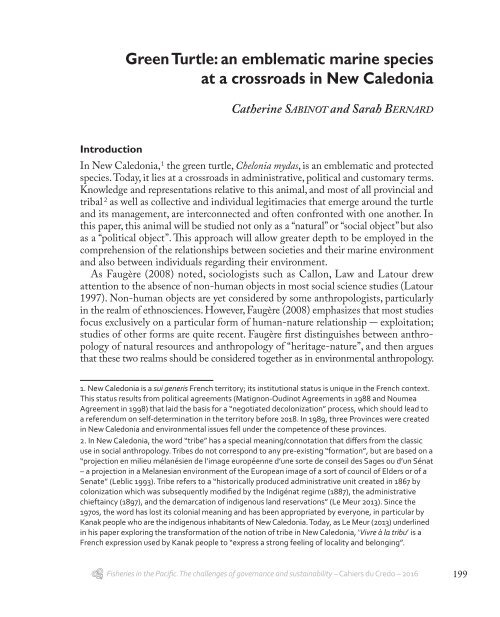Fisheries in the Pacific
Fisheries_in_the_Pacific
Fisheries_in_the_Pacific
You also want an ePaper? Increase the reach of your titles
YUMPU automatically turns print PDFs into web optimized ePapers that Google loves.
Green Turtle: an emblematic mar<strong>in</strong>e species<br />
at a crossroads <strong>in</strong> New Caledonia<br />
Ca<strong>the</strong>r<strong>in</strong>e SABINOT and Sarah BERNARD<br />
Introduction<br />
In New Caledonia, 1 <strong>the</strong> green turtle, Chelonia mydas, is an emblematic and protected<br />
species. Today, it lies at a crossroads <strong>in</strong> adm<strong>in</strong>istrative, political and customary terms.<br />
Knowledge and representations relative to this animal, and most of all prov<strong>in</strong>cial and<br />
tribal 2 as well as collective and <strong>in</strong>dividual legitimacies that emerge around <strong>the</strong> turtle<br />
and its management, are <strong>in</strong>terconnected and often confronted with one ano<strong>the</strong>r. In<br />
this paper, this animal will be studied not only as a “natural” or “social object” but also<br />
as a “political object”. This approach will allow greater depth to be employed <strong>in</strong> <strong>the</strong><br />
comprehension of <strong>the</strong> relationships between societies and <strong>the</strong>ir mar<strong>in</strong>e environment<br />
and also between <strong>in</strong>dividuals regard<strong>in</strong>g <strong>the</strong>ir environment.<br />
As Faugère (2008) noted, sociologists such as Callon, Law and Latour drew<br />
attention to <strong>the</strong> absence of non-human objects <strong>in</strong> most social science studies (Latour<br />
1997). Non-human objects are yet considered by some anthropologists, particularly<br />
<strong>in</strong> <strong>the</strong> realm of ethnosciences. However, Faugère (2008) emphasizes that most studies<br />
focus exclusively on a particular form of human-nature relationship exploitation;<br />
studies of o<strong>the</strong>r forms are quite recent. Faugère first dist<strong>in</strong>guishes between anthropology<br />
of natural resources and anthropology of “heritage-nature”, and <strong>the</strong>n argues<br />
that <strong>the</strong>se two realms should be considered toge<strong>the</strong>r as <strong>in</strong> environmental anthropology.<br />
1. New Caledonia is a sui generis French territory; its <strong>in</strong>stitutional status is unique <strong>in</strong> <strong>the</strong> French context.<br />
This status results from political agreements (Matignon-Oud<strong>in</strong>ot Agreements <strong>in</strong> 1988 and Noumea<br />
Agreement <strong>in</strong> 1998) that laid <strong>the</strong> basis for a “negotiated decolonization” process, which should lead to<br />
a referendum on self-determ<strong>in</strong>ation <strong>in</strong> <strong>the</strong> territory before 2018. In 1989, three Prov<strong>in</strong>ces were created<br />
<strong>in</strong> New Caledonia and environmental issues fell under <strong>the</strong> competence of <strong>the</strong>se prov<strong>in</strong>ces.<br />
2. In New Caledonia, <strong>the</strong> word “tribe” has a special mean<strong>in</strong>g/connotation that differs from <strong>the</strong> classic<br />
use <strong>in</strong> social anthropology. Tribes do not correspond to any pre-exist<strong>in</strong>g “formation”, but are based on a<br />
“projection en milieu mélanésien de l’image européenne d’une sorte de conseil des Sages ou d’un Sénat<br />
– a projection <strong>in</strong> a Melanesian environment of <strong>the</strong> European image of a sort of council of Elders or of a<br />
Senate” (Leblic 1993). Tribe refers to a “historically produced adm<strong>in</strong>istrative unit created <strong>in</strong> 1867 by<br />
colonization which was subsequently modified by <strong>the</strong> Indigénat regime (1887), <strong>the</strong> adm<strong>in</strong>istrative<br />
chiefta<strong>in</strong>cy (1897), and <strong>the</strong> demarcation of <strong>in</strong>digenous land reservations” (Le Meur 2013). S<strong>in</strong>ce <strong>the</strong><br />
1970s, <strong>the</strong> word has lost its colonial mean<strong>in</strong>g and has been appropriated by everyone, <strong>in</strong> particular by<br />
Kanak people who are <strong>the</strong> <strong>in</strong>digenous <strong>in</strong>habitants of New Caledonia. Today, as Le Meur (2013) underl<strong>in</strong>ed<br />
<strong>in</strong> his paper explor<strong>in</strong>g <strong>the</strong> transformation of <strong>the</strong> notion of tribe <strong>in</strong> New Caledonia, ‘Vivre à la tribu’ is a<br />
French expression used by Kanak people to “express a strong feel<strong>in</strong>g of locality and belong<strong>in</strong>g”.<br />
<strong>Fisheries</strong> <strong>in</strong> <strong>the</strong> <strong>Pacific</strong>. The challenges of governance and susta<strong>in</strong>ability – Cahiers du Credo – 2016 199


